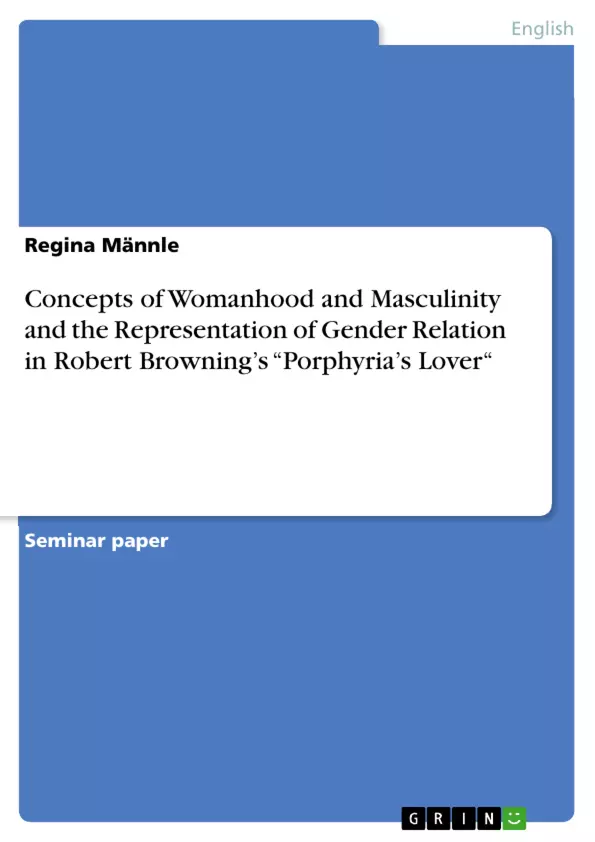Without a doubt, the Victorian age can be considered as a very vibrant era, an age of change and development, a time of expansion, reforms and of technological and scientific advance. It was only natural that these changes would affect the traditional religious and social beliefs and conventions, as well. The conventional gender system with its strict hierarchy and role expectations was mostly still intact and sexuality and corporeality were considered to be taboo subjects. Nevertheless, it was exactly this attempt to avoid sexuality and gender topics which led to sometimes excessive discussions about these issues, for example the so called “Great Evil” of prostitution and related to that the enforcement of the Contagious Disease Acts in the 1860s. These discussions, however, made many Victorians – for example the “New Women” that formed the basis for the later on emerging feminism – aware of the injustice of the status quo and led to a questioning of the traditional separate spheres ideology. The ideas of womanhood and masculinity had to be discussed and to be adapted to a new age. Although the stereotype of the “uptight Victorian” lives on until today, the literature of this time – since literature always mirrors the cultural climate of the society in which it came into being – demonstrates the Victorian’s interest in gender questions. In this paper Robert Browning will serve as an example for a poet highly aware of these ongoing changes. In his dramatic monologue “Porphyria’s Lover” he takes up the gender issue and deals with femininity, manliness and sexuality. The first chapter of this paper will give some information about the form of the dramatic monologue as a special means to present a person’s inner life and furthermore, will deal with the conventional idea of gender in the Victorian age. On the basis of this more general infor-mation, the second chapter will have a closer look at the poem itself and will compare the concept of gender roles and the construction of gender relationship designed by Browning with the traditional gender ideology. Browning’s way of dealing with this issue will be taken as one example for the Victorian’s awareness of the complexity of the gender question.
Table of Contents
- I. Introduction
- II. The Development of the Dramatic Monologue and the Victorian Ideals of Womanhood and Manliness
- II.1 The Dramatic Monologue – Development, Aims and Effects
- II.2. Concepts of Gender in the Victorian Age
- III. Womanhood, Masculinity and Gender Relation in “Porphyria's Lover”
- III.1. “Porphyria's Lover\" - A Prototypical Dramatic Monologue?
- III.2 The Speaker, His Beloved and the Blurring of Sexual Roles
- IV. Conclusion
Objectives and Key Themes
This paper aims to analyze Robert Browning's "Porphyria's Lover" and its exploration of gender roles and relationships within the context of Victorian society. It examines the development of the dramatic monologue as a literary form and its contribution to understanding the Victorian psyche.- The evolution of the dramatic monologue and its relation to Victorian anxieties about selfhood and subjectivity.
- Victorian ideals of womanhood and manliness, including the “angel in the house” and the pressure on men in the “public sphere.”
- The portrayal of gender relations in "Porphyria's Lover" and the blurring of traditional gender roles by the speaker.
- The poem's exploration of repressed sexuality and its potential connection to mental instability.
- Browning's contribution to the ongoing Victorian conversation about gender, sexuality, and societal expectations.
Chapter Summaries
- Introduction: The introduction sets the scene for the paper, highlighting the Victorian era's dynamic changes in societal structures, religious beliefs, and gender expectations. It points to the contradiction between traditional gender roles and the rising interest in discussing sexuality and corporeality, particularly through the phenomenon of the “New Woman” and the “Great Evil” of prostitution. This context lays the groundwork for understanding the complexities of gender in Victorian literature, including Browning's work.
- The Development of the Dramatic Monologue and the Victorian Ideals of Womanhood and Manliness: This chapter explores the dramatic monologue as a literary form that emerged in the Victorian era, reflecting the evolving interest in the inner lives of individuals. It examines the origins of the dramatic monologue, its relationship to the development of psychology, and its role in presenting characters' inner thoughts and motivations. The chapter also discusses Victorian ideals of gender, contrasting the idealized “angel in the house” with the pressures facing men in the public sphere. This section provides the foundation for understanding the gender dynamics at play in "Porphyria's Lover."
- Womanhood, Masculinity and Gender Relation in “Porphyria's Lover”: This chapter delves into Browning's poem "Porphyria's Lover," examining its relationship to the characteristics of a prototypical dramatic monologue. It explores the speaker's inner world, his perception of Porphyria, and the complex interplay of masculinity and femininity in the poem. This chapter likely examines how Browning's portrayal of gender roles challenges or reinforces Victorian conventions.
Keywords
This paper focuses on the Victorian era, gender roles, the dramatic monologue, Robert Browning, “Porphyria's Lover,” “angel in the house,” “public sphere,” repressed sexuality, mental instability, and Victorian societal anxieties.- Quote paper
- Dipl.-Bibl. Regina Männle (Author), 2006, Concepts of Womanhood and Masculinity and the Representation of Gender Relation in Robert Browning’s “Porphyria’s Lover“, Munich, GRIN Verlag, https://www.grin.com/document/120973



